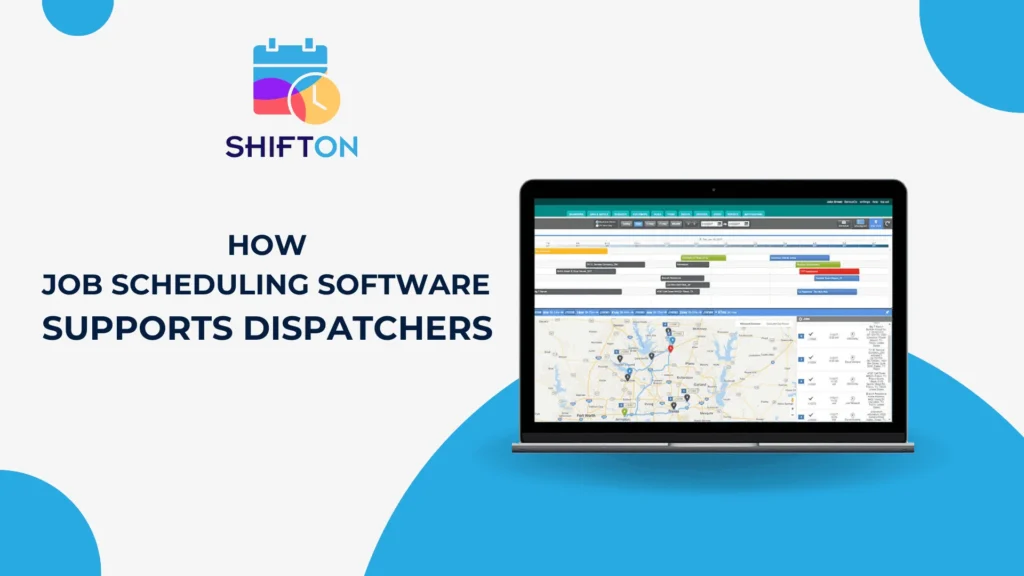In today’s world, where speed and efficiency are crucial, task
scheduling and dispatching software is becoming an essential tool for dispatchers. These professionals are tasked with coordinating various processes, managing resources, and optimising working time. The use of specialised software can greatly simplify their tasks by providing clear organisation of processes, minimising errors, and boosting overall productivity. In this text, we will explore how
scheduling and dispatching software systems impact dispatchers' work, the benefits they offer, and how they help improve team collaboration.
What Is Job Scheduling And Dispatch Software
There is a question:
what is job scheduling? Work
scheduling and dispatching software are specialised applications designed to optimise the management of tasks, resources, and time across industries. These are powerful tools that help organisations to align their operations more effectively, manage work schedules, and coordinate interactions between different departments.The primary purpose of such software is to automate routine tasks, thereby reducing errors, simplifying supervision, and enhancing overall team productivity. These systems allow dispatchers to monitor the status of tasks in real-time, allocate resources, and respond to problems in a timely manner.Key functions of
scheduling and dispatching software include creating and managing projects, scheduling, monitoring task completion, and analysing performance. Thanks to modern technologies such as cloud-based solutions and integration with other systems, such a programme can be accessed anytime and from anywhere, significantly increasing the flexibility of work.
The Benefits of Using Job Scheduling Software for Dispatchers
In today’s world where speed and efficiency are of utmost importance, utilising job
scheduling and dispatching software is becoming a necessity for dispatchers. Such platforms not only simplify the management of tasks but also offer numerous benefits that assist in optimising a company's operations. Let’s examine the main ones below.
Visibility for Contractors and Employees
One of the major advantages of job
scheduling and dispatching software is increased visibility. Thanks to interactive dashboards and graphical interfaces, everyone involved in the process can access up-to-date information about current and upcoming tasks at any time. This enables contractors and employees to quickly navigate their responsibilities and eliminates the possibility of miscommunication. Visibility of processes not only aids contractors but also managers in controlling task completion and making adjustments promptly.
Assigning the Best-Suited Technicians
Job
scheduling and dispatching software can greatly simplify the assignment of specialists to certain tasks. Using built-in algorithms and the ability to analyse data, the system can automatically determine which employees have the necessary skills and experience to perform a particular job. This helps to avoid situations where an unsuitable specialist is assigned to a task, thereby enhancing the quality of work performance and customer satisfaction.
Enhanced Time Tracking and Attendance Monitoring
An extremely important aspect of management activities is keeping track of employee time and attendance. Job
scheduling and dispatching software allows you to track how much time each specialist spends on tasks, as well as monitor actual attendance. This not only aids in payroll calculations but also allows you to identify bottlenecks in the process, optimising resource allocation.
Fewer Scheduling Conflicts
A lack of clear organisation often leads to scheduling conflicts when multiple tasks overlap or delays occur. Job
scheduling and dispatching software systems avoid these situations by automatically allocating resources and tasks. Dispatchers can see the workload of specialists in advance and adjust schedules, significantly reducing the number of conflict situations.
Optimised Dynamic Route Planning
Dynamic route planning is an important aspect of a dispatcher's work, especially in logistics and transport services. Modern software includes features that allow you to monitor traffic conditions in real-time and adjust routes based on traffic jams, weather conditions, or other factors. This not only saves time but also reduces fuel costs, which in turn helps improve the cost-effectiveness of the business.
Field App Access to Job Details
Scheduling systems often provide the ability to access job details through mobile apps. This is particularly relevant for field teams, where quickly obtaining data can have a significant impact on the bottom line. Professionals can receive notifications of new assignments, schedule changes, and task recommendations without leaving their desk.
Improved Team and Customer Collaboration
Job
scheduling and dispatching software enhances communication not only within the team but also with clients. All project participants can easily share information, ask questions, and receive answers in real-time. This fosters a more transparent and trusting relationship, which in turn contributes to increased customer satisfaction.
Convenient File Access and Sharing
Having easy access to the documents and resources you need is also important. Many
scheduling and dispatching software systems offer document management features, allowing one-click access to all the necessary files associated with a particular job. This streamlines information sharing and ensures that critical materials are available to everyone involved in the process.
Leveraging Mobile Capabilities
Modern job
scheduling and dispatching software systems increasingly offer solutions that are compatible with mobile devices. This allows employees and dispatchers to work from anywhere, which is particularly vital for businesses with active field operations. Mobile apps provide work flexibility, enabling real-time operational updates and job management.
Actionable Job Insights for Better Scheduling
Continuous access to up-to-date job information allows dispatchers to make more informed decisions based on real data. This not only speeds up the planning process but also makes it more accurate. With timely information, changes can be reacted to swiftly, adjusting plans and resource allocation.Therefore, the use of job
scheduling and dispatching software opens up numerous opportunities for dispatchers to enhance efficiency, improve collaboration, and minimise conflicts.This becomes particularly relevant in an increasingly competitive environment, where every detail can influence business success.
The Importance Of Job Scheduling Software For A Dispatcher
In modern business, especially in areas that require high coordination and management of resources, job
scheduling and dispatching software programmes have become essential tools for dispatchers. Their impact on team efficiency and task success is significant. Let’s examine the key aspects that highlight the importance of
scheduling and dispatching software.
Access All Schedules From A Single View
One of the major benefits of job
scheduling and dispatching software is the ability to have unified access to all schedules and plans. This not only simplifies the tasks of dispatchers but also substantially speeds up the decision-making process. Instead of switching between different sources of information, the dispatcher can view all the information they need in one interface. This includes schedules, employee utilisation, resource availability, and current task status. This access enables faster responses to changes in workflow and quicker re
scheduling and dispatching in the case of unforeseen circumstances. For example, if an employee falls ill or a project timeline changes, the dispatcher can reassign tasks in real-time without wasting valuable time searching for information in different systems.
Streamline Work Order Scheduling
Effective work order
scheduling and dispatching software is not only the key to successful task completion but also the key to company profits. Planning software helps automate and optimise this process. Most such systems have integrated algorithms that analyse the current workload, available resources, and customer needs. Thus, based on the data collected, the software can suggest optimal routes to fulfil orders, significantly reducing downtime and increasing productivity. For instance, a dispatcher can set parameters and the system will independently highlight cases when it is optimal to fulfil several orders simultaneously using a single resource.
Track Work Order Progress
Tracking work order progress is another crucial feature provided by
scheduling and dispatching software. Modern systems allow you to monitor the status of tasks in real-time, giving dispatchers the ability to quickly address issues. If any task is delayed, the system can automatically generate alerts, offering alternative solutions to minimise the impact of such delays on overall performance. Moreover, the software is often integrated with reporting systems, allowing for quick generation of reports and analysis of the performance of different orders.
Mobile Solutions For Dispatch Teams
Mobile technology also plays a crucial role in modern job
scheduling and dispatching software. Many programmes offer mobile apps that allow dispatchers and employees to stay connected and access plans anytime, anywhere. This is especially important when employees are travelling or working at remote sites. With mobile solutions, dispatchers can make changes directly from the field, update task statuses, and receive feedback from performers. This not only speeds up communication but also makes it more efficient, allowing everyone involved to stay informed and avoid misunderstandings.
How to Properly Utilise Automation and Improve Your Job Scheduling
Automating business processes can reduce routine tasks, improve accuracy, and speed up turnaround time. First, an organisation must determine which processes can be automated. This may include:
- Scheduling automation: Using software to create work schedules and assign tasks avoids errors and miscommunications. AI-powered systems can analyse workloads and suggest optimal solutions.
- Reporting and analytics: Implementing tools to automatically generate reports will enable you to track tasks and adjust plans in real-time. This helps to respond to changes quickly and increase the overall flexibility of the organisation.
In today's economy, where speed and accuracy of task execution play a crucial role, it is important to adeptly use automation to optimise business processes.
Linking Tasks With Technicians
Effective communication between different departments is essential for the successful completion of projects. Automated task management systems can link task assignments to specific technicians, taking into account their qualifications and availability. This prevents delays and misunderstandings, increasing the responsibility of each team member.
Ensuring Timely Parts Ordering And Availability
Today's technology allows the supply chain to be set up in such a way as to avoid shortages of needed materials. Key steps in this process include:
- Supplier integration: Creating automated systems for ordering parts lets you track inventory in real time and automatically trigger the ordering process when a certain level is reached. This minimises the risk of workflow stoppages due to material shortages.
- Inventory Management: Using an inventory management system will not only let you keep track of your current inventory, but also make forecasts based on analysing previous data. This is especially important in an uncertain market.
- Communication with technical experts: A key element in this process is maintaining ongoing communication with technicians who can communicate the need for additional materials before shortages occur. Automated messaging systems can help simplify this process and make it more transparent.
Enhancing Worker Dispatch Efficiency
Workflow dispatching is an integral part of any production cycle. The following aspects are worth considering, improving its effectiveness:
- Real-time monitoring: Implementing technology to track the status of tasks allows dispatchers to respond quickly to issues that arise. Using mobile apps to track task completion will make the process even more transparent.
- Optimise routing: When planning routes and assigning tasks, factors such as traffic congestion, work schedules and resource availability must be considered. Automated systems can suggest optimal routes and schedules, which will significantly reduce the time it takes to complete tasks.
- Feedback and training: Collecting task performance data and analysing it helps identify weaknesses in workflow. Employee training based on the data obtained allows for continuous improvement of dispatching quality.
Proper use of automation, work
scheduling and dispatching software, organisation contributes to significant efficiency gains, cost savings and improved communication within the team. Linking tasks to technicians, ensuring timely ordering of parts, and optimising workforce dispatching are all essential to creating a successful business that can adapt to changing market conditions. Adopting modern technology and continuous process improvement are essential to the sustainability of your organisation.
Closing Thoughts. How Shifton Can Help with Scheduling Dispatchers Job
Shifton offers an intuitive interface and powerful automation tools that enable dispatchers to efficiently allocate tasks and optimise work
scheduling and dispatching software in real time. Through data analytics and predictive algorithms, the system helps anticipate needs, improve team communication and reduce errors, which in turn improves overall productivity. In this way, Shifton becomes an indispensable aid in creating a harmonious
scheduling and dispatching software system, allowing dispatchers to focus on the more important aspects of their work rather than on mundane tasks!
Daria Olieshko
A personal blog created for those who are looking for proven practices.

 English (US)
English (US)  English (GB)
English (GB)  English (CA)
English (CA)  English (AU)
English (AU)  English (NZ)
English (NZ)  English (ZA)
English (ZA)  Español (ES)
Español (ES)  Español (MX)
Español (MX)  Español (AR)
Español (AR)  Português (BR)
Português (BR)  Português (PT)
Português (PT)  Deutsch (DE)
Deutsch (DE)  Deutsch (AT)
Deutsch (AT)  Français (FR)
Français (FR)  Français (BE)
Français (BE)  Français (CA)
Français (CA)  Italiano
Italiano  日本語
日本語  中文
中文  हिन्दी
हिन्दी  עברית
עברית  العربية
العربية  한국어
한국어  Nederlands
Nederlands  Polski
Polski  Türkçe
Türkçe  Українська
Українська  Русский
Русский  Magyar
Magyar  Română
Română  Čeština
Čeština  Български
Български  Ελληνικά
Ελληνικά  Svenska
Svenska  Dansk
Dansk  Norsk
Norsk  Suomi
Suomi  Bahasa
Bahasa  Tiếng Việt
Tiếng Việt  Tagalog
Tagalog  ไทย
ไทย  Latviešu
Latviešu  Lietuvių
Lietuvių  Eesti
Eesti  Slovenčina
Slovenčina  Slovenski
Slovenski  Hrvatski
Hrvatski  Македонски
Македонски  Қазақ
Қазақ  Azərbaycan
Azərbaycan  বাংলা
বাংলা 


